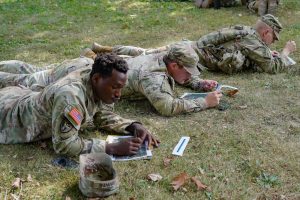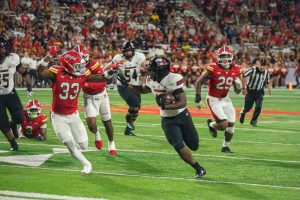Iran-US relations grow increasingly tense
January 20, 2020
DeKALB — The most recent events in the ongoing Iran-U.S. conflict began when the U.S. blamed Kataib Hezbollah, an Iranian-backed Iraqi militia, for a Dec. 27 rocket attack that killed an American defense contractor, a charge Kataib Hezbollah has denied.
Two days later, in retaliation for the attack, the U.S. executed a series of airstrikes on facilities in Syria and Iraq. A Dec. 29 news release from the U.S. Department of Defense said these facilities were used by Kataib Hezbollah “to plan and execute attacks” against a U.S.-led joint task force.
Dec. 30, Kataib Hezbollah said 25 of its members were killed in the airstrikes and declared revenge for the deaths of its fighters. The next day, dozens of Iraqi protesters, in solidarity with Kataib Hezbollah, breached the U.S. embassy in Baghdad and set fire to the reception area of the compound.
Tensions between the U.S. and Iran reached new heights after Quds Force commander Qasem Soleimani, a popular figure in Iran, was killed Jan. 3 in a targeted U.S. airstrike ordered by President Donald Trump.
The Quds Force is a special operations unit within the Islamic Revolutionary Guard Corps, a branch of the Iranian Armed Forces. The U.S. Department of State, under Trump, designated the IRGC as a terrorist organization in April.
In a statement released the day of Soleimani’s death, the Department of Defense claimed Soleimani was “actively developing plans to attack American diplomats and service members in Iraq and throughout the region.”
Soleimani is considered a hero by many in Iran for assisting Iraqi and Syrian forces in their fight against the Islamic State, according to the Associated Press.
The killing of Soleimani was met with strong disapproval from Iranian leaders. In a Jan. 3 statement, Iran’s supreme leader Ayatollah Ali Khamenei said, “Harsh vengeance awaits the criminals that got [Soleimani’s] and other martyrs’ blood on their evil hands in last night’s incident.”
Additionally, Iranian President Hassan Rouhani said in a Jan. 3 tweet that retaliatory measures will be taken against the U.S. to avenge Soleimani’s death.
“The flag of General Soleimani in defense of the country’s territorial integrity and the fight against terrorism and extremism in the region will be raised, and the path of resistance to US excesses will continue,” the tweet said. “The great nation of Iran will take revenge for this heinous crime.”
By Jan. 4, the U.S. had deployed about 3,500 additional troops to the Middle East. About 750 of these troops were deployed from the Immediate Response Force of the 82nd Airborne Division in Fort Bragg, North Carolina, following the embassy attack, while the rest were deployed following the airstrike that killed Soleimani, according to CNN.
The Trump administration has received considerable scrutiny over the legitimacy of an “imminent” Iranian threat that would justify the assassination of one of Iran’s top military generals.
In a Jan. 9 one-on-one interview for Fox News, Secretary of State Mike Pompeo said there was “no doubt” Soleimani was behind a series of plans to attack American citizens but couldn’t say when or where these alleged plans would’ve taken place.
Members of Congress from both parties—including House Speaker Nancy Pelosi—have voiced their opposition to Trump’s ordering the assassination of Soleimani on the grounds that congressional approval wasn’t sought beforehand, as is required by the War Powers Resolution.
Among these legislators is GOP Sen. Mike Lee of Utah, who expressed disgust on Fox News over the Trump administration’s inept briefing of the Soleimani killing on Jan. 8.
“[The briefers] were asked repeatedly, ‘What, if anything, would trigger the need for the administration to come back to Congress for a declaration of war or an authorization for the use of military force?’” Lee said. “At one point, I believe one of the briefers said something along the lines of, ‘I’m sure we could think of something.’ But they struggled to identify anything.”
Jan. 8, Iran proceeded to launch ballistic missiles at Iraqi bases housing U.S. troops in retaliation for Soleimani’s assassination. There were reportedly no American fatalities.
That same day, a commercial jet from Ukrainian International Airlines crashed shortly after takeoff from Imam Khomeini International Airport in Tehran, killing all 176 people on board.
Jan. 11, after initially denying its involvement, Iran admitted to shooting the plane down by mistake in a missile strike. The strike was reportedly ordered out of fear of an impending U.S. retaliation.
Following the revelation of Iranian military responsibility for the crash, Khamenei called for an investigation of the “possible shortcomings” that led to the event. Iranian protesters gathered in Tehran and other cities calling for Khamenei’s resignation over the Iranian government’s mishandling of the situation and the cover-up of what happened.
How can students be affected?
Multiple news outlets reported that FAFSA had been trending on Twitter shortly after it was revealed that Soleimani had been killed by U.S. forces, with many college students expressing anxiety over the possibility of a military draft if war breaks out.
Selective Service, or draft, registration is offered in Question 22 of the online FAFSA form. Required applicants who haven’t already been registered may do so by manually selecting the option “Register Me,” according to FAFSA’s website.
All male applicants from ages 18 to 25 must register with Selective Service to be eligible to receive federal financial aid of any kind, according to the Federal Student Aid website. This includes grants, work-study and loans.
In response to growing concerns over a possible draft, on Jan. 3, FAFSA tweeted facts surrounding how the draft process works, emphasizing why it would be unlikely for one to occur.
“[The] U.S. military has been all-volunteer since 1973 & Congress would need to pass a new law to institute a draft,” one tweet read.
FAFSA backed this up by quoting a tweet from Selective Service. The tweet read, “There is no priority order for Selective Service based on the FAFSA form (they use a random lottery number and year of birth).”
However, there are NIU students serving in the U.S. Armed Forces, whether on active duty or in the reserve components, who can be called upon for deployment in cases of emergency.
Active duty service members are full-time military employees who can be deployed at any time, while those serving in a military reserve unit work part-time but can also be deployed when needed, according to the Veteran Affairs website.
“There are students who are on active duty, and they take classes remotely, such as online classes,” Tucker Carpenter, VA student benefits counselor for NIU’s Military and Post-Traditional Student Services, said. “But primarily, the majority of on-campus students that [our office deals] with are either prior active duty and they’ve … ended their obligation and their contract is over, or they’re currently serving in one of the reserve facets of the military.”
Carpenter said NIU allows military students who are called upon during a semester the opportunity to complete their courses when they return from deployment.
“Depending on how far along they are into the semester of their classes, and their standing in the class, it’s possible they could be provided with [an] ‘incomplete’ for the class, in which they come back, return from their active duty status and continue taking that course,” he said.






